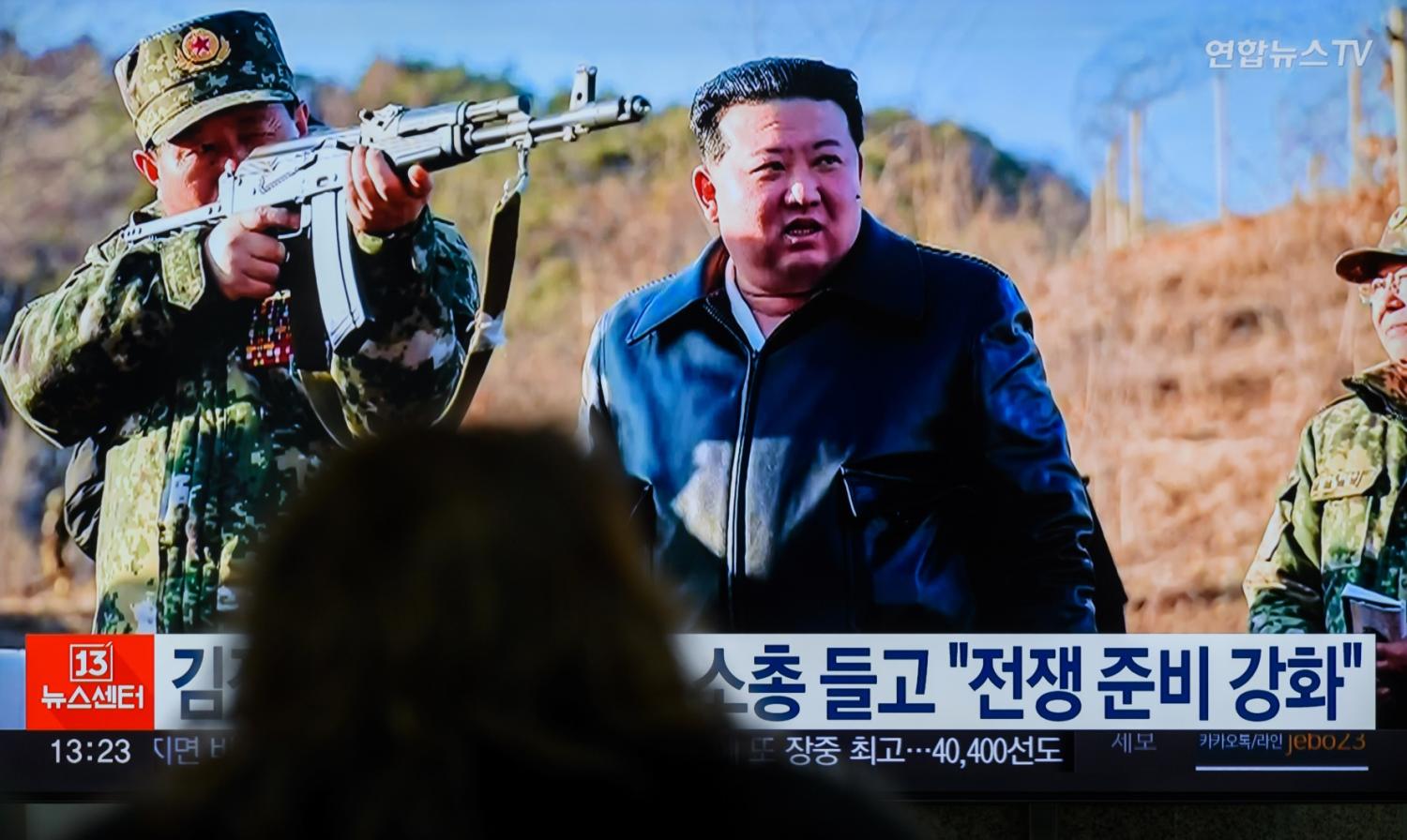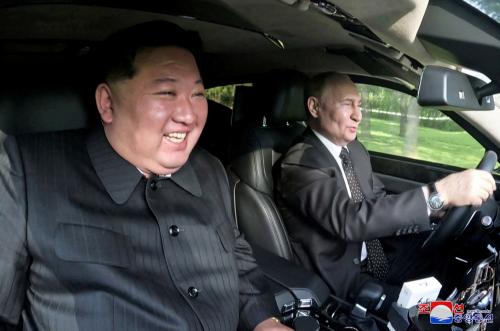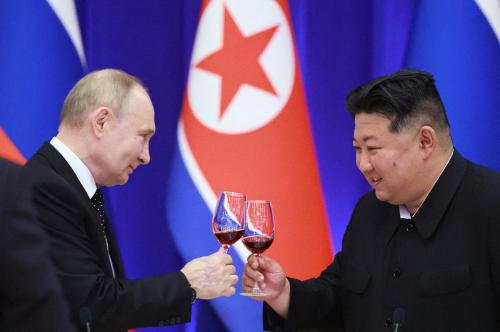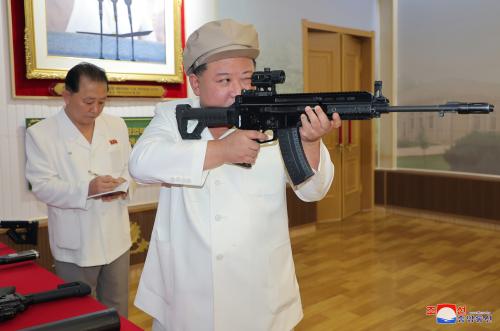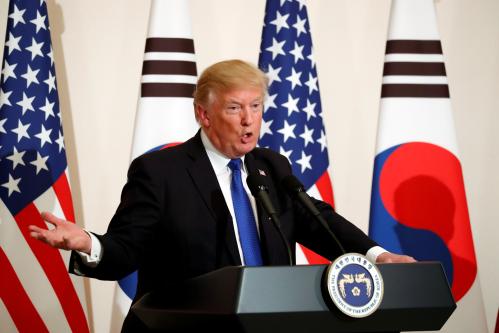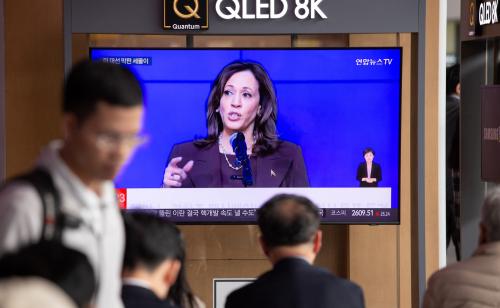Executive summary
Although U.S.-China competition, Russia’s war in Ukraine, and conflict in the Middle East loom large as top foreign policy issues in the upcoming 2024 U.S. elections, presidential candidates Joe Biden and Donald Trump will need to address escalating tensions on the Korean Peninsula and U.S.-North Korea relations. Since the collapse of the Hanoi Summit in February 2019, North Korea has adopted a more offensive nuclear doctrine, advanced its missile and satellite technology, improved its cyber capabilities, and strengthened political ties with Russia and China. However, the expected rematch between Biden and Trump in 2024 presents a stark contrast in how the two candidates might address North Korea and its nuclear program in a second term.
Both candidates want to project strength and confidence. However, when examining their records, the two leaders diverge in their respective approaches to North Korea. Trump prefers a top-down style, interacting with leaders one-on-one. Meanwhile, Biden coordinates closely with allies and partners, taking cues from the working-level in a bottom-up fashion.
Pyongyang’s unwillingness to relinquish its nuclear weapons limits the range of policies available to the United States but also forces the next administration to be flexible and disciplined when approaching the North Korea problem. As November approaches, both candidates should consider building a wider coalition of partners willing to monitor North Korea’s illicit activity and sanctions evasion; seek common ground with Beijing in reorienting Pyongyang to the negotiating table; and consistently advocate for North Korean human rights.
North Korea and the 2024 U.S. election
Three decades of U.S.-North Korea nuclear diplomacy have left U.S. officials skeptical of any nuclear deal with North Korea. Meanwhile, the North Korea conundrum has only worsened in the absence of diplomacy between Washington and Pyongyang since 2019. In addition to conducting 106 missile launches since 2022, North Korea’s partnerships with China and Russia have enabled Kim Jong Un’s regime to skirt U.N. sanctions, transfer and receive critical technologies, and provide opportunities to test North Korean weapons on the Ukrainian battlefield. The Treaty on Comprehensive Strategic Partnership signed during the June 2024 Kim-Putin summit further demonstrates North Korea’s intent to expand military-technical cooperation and undermine U.S. influence.
Although North Korean issues remain lower on the list of U.S. foreign policy priorities considering two wars and competition with China, the newfound Russia-North Korea alliance illustrates how the brewing crisis on the Korean Peninsula relates to wider geopolitical contestation. Trump may be more inclined to engage with Kim given their past rapport. However, high-stakes diplomacy with North Korea would be ill-advised if engagement is pursued at the cost of undermining regional alliance cohesion and deterrence. For Biden, the impasse in North Korean denuclearization may lead his administration to draw greater attention to linkages between North Korea and other adversaries, including Russia, China, and Iran. But doing so would not necessarily improve an already worsening security environment in Northeast Asia without some path to dialogue with North Korea.
On North Korea issues, the top priority for the next U.S. administration is halting, if not reversing, progress in the regime’s nuclear and weapons programs. An early task for the next U.S. administration is to rebuild a coalition of partners willing to monitor North Korea’s illicit activity, enforce a weakened sanctions regime, and counter North Korean cyberactivity following Russia’s veto of the resolution renewing the U.N. Panel of Experts’ mandate to investigate such activities. Although Republicans and Democrats remain critical of China, the next administration should also seek cooperation with Beijing to support peace and stability on the Korean Peninsula, particularly in light of strengthened North Korea-Russia ties. Finally, Trump or Biden must consistently advocate for North Korean human rights, including enhancing North Koreans’ access to information. Although the Kim regime remains resilient for now, its legitimacy could be challenged down the road by disgruntled elites in the wake of internal or external challenges, particularly if Kim’s health deteriorates and succession plans for the fourth generation of Kim rule are unclear or contested.
A few points bear in mind as American voters consider how Trump and Biden might address a deteriorating security situation on the Korean Peninsula. First, Trump may raise the issue of North Korea on the campaign trail given his previous engagement with Kim during two high-profile summits in Singapore in June 2018 and Hanoi in February 2019, respectively. Despite the absence of a deal, Trump may tout his own ability to bring Kim to the diplomatic table and (misleadingly) criticize Biden for not only failing to hold a single dialogue with North Korea but also enabling the regime to dramatically ratchet up provocations on Biden’s watch.
Second, Biden can point to his administration’s ability to closely coordinate policy with U.S. allies to ensure that deterrence is maintained on the peninsula despite North Korea’s escalatory actions. Biden may also cast blame on Trump for naively and prematurely pursuing two high-level summits with Kim and weakening military readiness and deterrence on the Korean Peninsula.
Third, regardless of whether either candidate includes North Korea in their campaign talking points, Kim may insert himself into the conversation by escalating tensions prior to the U.S. elections if he believes such actions offer an advantage to Trump, his preferred candidate. In addition to his past rapport with Kim, Trump is more willing to break with diplomatic orthodoxy. By stirring up trouble, Pyongyang could help set the table for an incoming Trump administration to return to the negotiating table and reduce tensions in return for concessions sought by Kim (and previously suggested by Trump), such as the reduction of U.S. troops or the suspension of joint military exercises with South Korea, which in turn would create a rift in the U.S.-South Korea alliance.
Assessing Trump’s past approach to North Korea
As a candidate in 2016, Trump expressed an interest in meeting Kim to discuss North Korea’s nuclear program. While this was a major shift in U.S. thinking on North Korea, the desire for a new approach was not unwarranted at the time given the lack of progress from past efforts, including the Agreed Framework, the Six-Party Talks, and strategic patience.
However, North Korea conducted two nuclear tests in 2016 and continued to exacerbate tensions on the global stage as Trump entered the White House in 2017. This included the release of imprisoned American student Otto Warmbier in a comatose state, the murder of Kim’s half-brother Kim Jong Nam in Malaysia, the successful testing of the first intercontinental ballistic missile (ICBM) capable of reaching the U.S. mainland, a sixth nuclear test, and multiple short- and medium-range missile launches. Amid these human rights abuses, the administration spotlighted human rights in North Korea by inviting Warmbier’s parents and a North Korean defector during Trump’s first State of the Union Address. On the nuclear front, Trump threatened “fire and fury like the world has never seen,” while Pyongyang warned it was considering striking Guam. The use of bombastic language by both sides increased fears of a nuclear war but also forced rare unity in the United Nations Security Council when China and Russia supported tougher new sanctions on North Korea.
Meanwhile, South Korea elected President Moon Jae-in, a progressive, who advocated for unconditional engagement and dialogue with Pyongyang, a departure from a decade of hardline conservative policy toward North Korea. Throughout the last half of 2017, Moon’s diplomatic outreach attempts to North Korea were largely ignored. During his annual New Year’s address in 2018, Kim signaled an openness to dialogue, capping off a foray into global diplomacy first with Beijing and then Seoul. With inter-Korean relations steadily improving, Kim took diplomacy a step further by expressing a willingness to relinquish his nuclear weapons if Washington committed to a formal end to the Korean War and promised to not attack the North. Given Moon’s desire for continued inter-Korean engagement, Moon positioned himself to bring Trump and Kim to the negotiating table.
Officials in the Trump administration continued to advocate for close coordination with U.S. allies to prevent Pyongyang from dividing the U.S.-South Korea alliance. However, Trump was eager to negotiate directly with Kim. On June 12, 2018, Trump became the first sitting U.S. president to meet a North Korean leader at the Singapore summit during which Pyongyang committed to the “complete denuclearization of the Korean Peninsula” without a detailed timeline and Washington pledged to “provide security guarantees.” Most notably, these guarantees included suspending joint military exercises with South Korea, which Trump claimed were provocative and a waste of money and time. This decision appeased North Korean hardliners but left some U.S. officials as well as Seoul and Tokyo in the lurch, bracing for future abrupt policy reversals and jeopardizing military readiness. Between South Korea and Japan, Seoul had the most to lose from this suspension as Trump officials “deliberately excluded” Moon amid concerns he was “too willing to make concessions to North Korea.”
In the aftermath of the Singapore summit, Trump was increasingly eager to make progress on North Korea before the 2018 midterm elections, but he believed that Moon was prioritizing unification and engagement over denuclearization. Progress on working-level negotiations continued to stall as North Korean officials threatened to remove denuclearization from the agenda. Amid the deadlock between U.S. and North Korean officials, Trump increased trade pressure on China to push Beijing to encourage Pyongyang to cooperate during negotiations.
In a last-ditch effort to salvage hopes for denuclearization, Trump and Kim met in Hanoi for a second summit hoping for a diplomatic breakthrough. According to then-National Security Advisor John Bolton, despite Trump’s desire to strike a deal, White House officials framed the second summit as “not make-or-break” and repeated the “if we walk, it’s okay” mantra to lower the stakes during briefings. Rather than settling for a bad deal, Trump abruptly walked away from the summit with no joint agreement, leaving the peninsula’s status quo intact.
An impromptu encounter between Kim and Trump on the North Korean side of the demilitarized zone in June 2019 suggested the possibility of resuming talks at a future date. Yet, Pyongyang resumed missile testing in the summer and fall of 2019 after a year of no missile launches in 2018, as shown in Figure 1.
Nevertheless, working-level negotiations between U.S. and North Korean officials ensued in October 2019 in Stockholm. However, the talks collapsed within hours over disagreements on how to dismantle Pyongyang’s nuclear program. As the COVID-19 pandemic began spreading around the world in 2020, North Korea closed its borders in January 2020 and retreated into isolation, evidently disinterested in engaging with the West or Seoul.
Biden’s approach to North Korea
During the 2020 presidential campaign, Biden criticized Trump’s “special friendship” with Kim and called Kim a “thug” during the second presidential debate. He slammed Trump for emboldening autocrats and raising the prospect of nuclear proliferation. As a candidate, Biden pledged to begin a “sustained, coordinated campaign with our allies and others—including China” to denuclearize North Korea.
Upon entering office, the Biden administration conducted a North Korea policy review and consulted with experts and officials from past administrations. Acknowledging past failures, the Biden administration stated that it would not seek any “grand bargain” as Trump did, nor would it follow the Obama-era policy of “strategic patience.” Rather, the Biden administration would pursue a “calibrated and practical approach” that would remain open to diplomacy with North Korea while making “practical progress [to] increase security in the United States—for the United States and our allies.” As one U.S. official at the time shared with the Washington Post, “If the Trump administration was everything for everything, Obama was nothing for nothing … this is something in the middle.”
Although Biden officials provided few details on the administration’s North Korea policy, Washington did appear intent on reaching out to Pyongyang, most notably by offering U.S.-produced COVID-19 vaccines and other forms of medical and humanitarian assistance. Moreover, then-U.S. Special Representative to the Democratic People’s Republic of Korea Ambassador Sung Kim and other top administration officials repeatedly offered to meet with North Korea “anywhere, anytime, without preconditions” to discuss denuclearization or other issues.
Despite the Biden administration’s early efforts to engage with Pyongyang on the humanitarian and diplomatic front, the Kim regime ignored U.S. overtures. Amidst a strict pandemic border lockdown, Pyongyang’s decision to self-isolate from the world exacerbated a chronic food insecurity crisis and unease over North Korea’s ability to contain a COVID-19 outbreak. Notwithstanding increased concerns over North Korea’s human rights situation, the Biden administration took nearly two years to nominate and confirm Special Envoy for North Korean Human Rights Issues Julie Turner, the first envoy in six years. Since then, Turner has reiterated support for dialogue with Pyongyang but has also elevated issues, such as returning abductees and family separation.
On the nuclear front, tensions on the Korean Peninsula dramatically escalated throughout 2022 with a record number of ballistic missile tests conducted that year (see Figure 1). North Korea also rapidly expanded its weapons capabilities, including powerful solid-fuel ICBMs, hypersonic missiles, reconnaissance satellites, submarines, and an underwater nuclear weapons system.
To counter these concerning developments, the Biden administration reinvigorated alliances with Japan and South Korea, while also expanding trilateral coordination with Tokyo and Seoul on North Korean provocations. In the absence of negotiations, Washington focused on strengthening its defense and deterrence capabilities. This included increasing joint military exercises and information sharing on North Korean missile launches with Seoul and Tokyo, deploying nuclear strategic assets to the Korean Peninsula, and establishing a nuclear consultative group with South Korea.
Although the Biden administration has made significant strides in strengthening alliances and improving defense and deterrence capabilities, it has not found a clear solution to decrease tensions between the United States and North Korea, and on the Korean Peninsula at large. Pyongyang’s refusal to respond to Washington and the absence of any inter-Korea or U.S.-North Korea dialogue has further militarized the peninsula and contributed to an arms race in Northeast Asia. Nevertheless, U.S. officials continue to emphasize the need to denuclearize North Korea and outline “interim steps” toward this goal. On the multilateral front, the United States has collaborated with allies and partners to impose sanctions, cut off illicit finance sources, and hold Pyongyang accountable for human rights abuses.
U.S.-North Korea relations under a second Biden or Trump administration
Trump’s and Biden’s past policy records on North Korea suggest a different set of opportunities and challenges for each candidate when dealing with Pyongyang. Denuclearization appears unlikely and risk mitigation, much less reengagement between the United States and North Korea, will be difficult under current geopolitical circumstances regardless of who enters the White House in 2025.
Since Kim’s retreat into disengagement, the emergence of bloc politics and the so-called China-Russia-North Korea axis have given Kim less incentive for dialogue with Washington, while Beijing and Moscow provide Pyongyang with material resources and diplomatic cover at the U.N. Security Council. Furthermore, the election of a conservative president in South Korea, Yoon Suk Yeol, in 2022 has shifted Seoul’s North Korea policy from engagement with Pyongyang to a more confrontational stance. Seoul would be unlikely to welcome another high-profile summit unless Kim makes substantial concessions on denuclearization.
Biden: More continuity and predictability, but less opportunity for a breakthrough
The Biden administration has taken a pragmatic approach to North Korea, remaining open to dialogue even without preconditioning denuclearization. Biden’s pragmatism has also meant approaching dialogue through diplomatic channels below the leader’s level and working closely with allies, particularly South Korea and Japan, to boost defense and deterrence against escalating nuclear threats. Biden’s North Korea policy has helped reassure allies of the U.S. commitment to defend them against a North Korea attack despite Pyongyang’s ever-increasing provocations. But his policy has also hit a wall with North Korea’s refusal to negotiate, and there has been little incentive to think outside of the box to break the impasse.
If North Korea continues its provocations and rejects dialogue with the United States, a second Biden administration may have little choice but to continue along similar lines to its current North Korea policy. In March 2024, Biden administration officials drew attention to an “interim steps” approach to denuclearization, which the South Korean media interpreted as a sign of greater flexibility in its approach to negotiating with North Korea. In other words, Washington was not insisting on denuclearization upfront. The concept, of course, is not new; it goes back to the days of the Six-Party talks in the early 2000s. Although hawks during the Trump administration rejected the step-by-step approach to denuclearization, other officials, including Trump himself, appeared to at least entertain such an approach. However, Biden’s commitment to non-proliferation reduces the administration’s flexibility to even tacitly recognize North Korea’s nuclear status, even if the United States focuses on risk reduction or confidence-building measures as an initial step.
Moreover, there would be little Biden could offer to Kim to pursue risk reduction steps. Sanctions relief and economic aid have not enticed Kim since 2019. On the security front, Biden is unlikely to reduce the U.S. military presence in South Korea or significantly scale back joint military exercises with South Korea (and Japan) given the effort his administration has made to strengthen bilateral and trilateral relations with allies. Even though a second Biden administration might try to exercise greater flexibility in reaching out to North Korea, it would prioritize its alliance commitments to Seoul and Tokyo and its firm position on denuclearization over diplomatic engagement with North Korea if such engagement weakens U.S. credibility and deterrence in the region.
Trump: Greater prospect for dialogue, but also higher risk
Under a second Trump administration, the range of opportunities and risks for U.S.-North Korea relations is wider. Republicans have generally adopted a hawkish stance on North Korea, seeking pressure through sanctions, isolation, and containment and taking a more vocal position on human rights. Although Trump followed this path during his first year in office in 2017, he later reversed course by engaging directly with Kim in 2018 and 2019.
It is possible that a second Trump administration might follow a hardline approach to North Korea given the Republican Party’s general distrust of communist regimes and conservatives’ penchant for pursuing “hawk engagement” with North Korea. However, in the absence of ideological blinders, Trump may be more open to dialogue with North Korea than those Republicans who hold more deep-rooted ideological reservations about engaging with a nuclear-armed, human-rights-violating pariah state. Three reasons suggest Trump is more likely than Biden to resume discussions with Kim.
First, Trump and Kim have developed a personal rapport. Even after the end of their “bromance” in 2019, Trump proclaimed on his Truth Social media account in December 2023, “I do get along well with Kim Jong Un!” The chill in U.S.-North Korea relations appears to have little bearing on how Trump sees Kim as a leader. If Trump is elected, a congratulatory statement from Kim may entice Trump to respond.
Second, Trump sees himself as a dealmaker. Trump may be motivated to complete unfinished business and seal the deal with North Korea, even if the agreement does not replicate the demands of the “grand bargain” his first administration sought in Hanoi. In the absence of any strong ideological views on non-proliferation, Trump may not demand this time that Kim “go big” by accepting complete denuclearization upfront.
Third, Trump’s ego and desire to shape his own legacy may be a further motivating factor to engage Kim. Trump seemed flattered in 2018 after receiving word about his nomination for the Nobel Peace Prize after the Singapore summit. When asked by reporters whether he deserved the prize, Trump humbly bragged, “Everyone thinks so, but I would never say it,” before stating that he wanted to see an agreement “finished” between the United States and North Korea. It would be tempting for Trump to become the first president to “solve” the North Korean nuclear problem (whether that entails denuclearization or not) and normalize U.S.-North Korea relations.
It remains unclear what might be gained by another Trump-Kim summit, or what Trump might offer Kim in exchange for North Korea dialing down provocations and suspending or rolling back its nuclear program. Skeptics worry that Trump might strike a bad deal with Kim that enables the regime to preserve its nuclear status without making any real commitments, thus worsening the security situation on the Korean Peninsula.
According to three sources who had been briefed on Trump’s thinking on North Korea and spoke to Politico, Trump might accept an agreement that focuses on an initial nuclear freeze and prevents the regime from developing new weapons in exchange for economic aid and financial investments. Trump has denied the claim that he is open to a nuclear North Korea as “disinformation.” However, the arguments outlined in the Politico piece suggest that the United States would at least implicitly and/or temporarily accept North Korea’s status as a nuclear power. Additionally, Trump may suggest the establishment of formal diplomatic ties or a U.S. liaison office in Pyongyang—a point Trump officials previously discussed in advance of the Hanoi summit, as well as under previous administrations—as a means of bringing North Korea to the table even prior to a full commitment to denuclearization.
A second Trump administration might resume direct diplomacy with North Korea, but doing so presents several risks. In contrast to Biden, Trump might be more willing to sacrifice coordination and unity with U.S. allies to make a deal with North Korea. Trump has proposed reducing U.S. forces on the Korean Peninsula and suspending joint military exercises. Such U.S. actions would be appealing to Kim, but it would also undermine military readiness, weaken deterrence against North Korea, and sow division between Seoul and Washington. Furthermore, the Yoon government remains hostile and distrusting of North Korea. Seoul would likely object to U.S.-North Korea dialogue without addressing North Korea’s complete denuclearization and South Korea’s security concerns.
Should Trump feel compelled to reassure South Korea about U.S.-North Korea diplomacy, he might permit Seoul to pursue its own nuclear capabilities to strengthen South Korea’s deterrence against a nuclear North Korea. Trump could also respond to South Korean popular support for redeploying U.S. tactical nuclear weapons on the Korean Peninsula or consider nuclear sharing arrangements between the United States and South Korea. Of course, such actions would be diplomatically costly for the Yoon government. The introduction of South Korean nukes could also magnify rather than diminish the security risks on the Korean Peninsula by triggering regional nuclear proliferation. Permitting a nuclear South Korea or the redeployment of U.S. tactical nuclear weapons on Korean soil would also be unacceptable to Kim.
Conclusion and policy recommendations
The upcoming U.S. election presents an opportunity to take stock of where U.S. policy on North Korea may head. Contrasting personality and leadership styles, as well as different political circumstances in South Korea and in global politics during Trump and Biden’s respective terms in office, have led the two candidates to pursue differing policies toward North Korea. Unfortunately, the policy options available to the next U.S. president will remain limited with a more confident Kim unwilling to relinquish North Korea’s nuclear weapons and strengthened by Russia. Domestically, Kim has reasserted control over the economy and adopted populist “people-first” projects including new housing construction and increased agriculture production. North Korea, therefore, has less incentive to engage the United States now than in 2018. Nevertheless, Trump and Biden might consider the following policy recommendations as they build out their foreign policy strategies.
First, Biden or Trump will need to staunch North Korea’s accelerating nuclear and weapons programs. This cannot be done by the United States alone. The Biden administration has spent the past four years reinvigorating alliances and building coalitions including the U.S.-Japan-South Korea trilateral. It may therefore be easier for a second Biden administration to strengthen networks and reach out to new partners in both the developed and developing world, to help monitor and enforce sanctions, and crack down on North Korean cybertheft. The United States should encourage like-minded allies and partners to push the North Korea agenda in other institutions and fora including the Association of Southeast Asian Nations, the European Union, and the G7.
Although there is an assumption that the Trump administration will do away with America’s alliances, Trump’s former national security advisor, Robert O’Brien, has insisted that “America first is not America alone.” With vital national interests at stake, Republicans may also see the value in building a network of countries to slow if not reverse North Korean nuclear proliferation. Managing the risks of a nuclear-armed North Korea should not be the work of a single country, but one that involves establishing trust and coordination with allies and other partners and requires a long-term commitment to preserving peace on the Korean Peninsula.
Second, the North Korea-Russia military alliance should motivate the United States to seek common ground with China in stabilizing the deteriorated security situation on the Korean Peninsula. Although Xi Jinping shares the same goal as Putin and Kim in weakening U.S. influence, China is uncomfortable with bloc politics and has stayed relatively muted about developing Russia-North Korea ties. As China scholar Patricia Kim argues, “Beijing is rapidly losing its influence with Pyongyang relative to Moscow, all the while paying the diplomatic costs of being associated with the two pariah states.” This reality for Beijing may provide the next administration with an opportunity to steer Beijing away from Moscow, or at least prevent China from further enabling Russia-North Korea cooperation. Diplomatic cooperation with China on the North Korea issue will prove to be challenging for both Biden and especially Trump as Republicans have embraced a “win at all costs” approach to U.S.-China competition. Still, Trump did press China in the past on North Korean issues, and Beijing’s support for North Korean sanctions was arguably higher during the Trump era than at present. The Biden administration has tried, unsuccessfully, to solicit Beijing’s cooperation. However, China’s weakening influence in North and South Korea and increasing instability on the peninsula may incentivize Beijing to press North Korea not to further undermine regional stability.
Finally, the United States must be prepared for the long game with North Korea. The Kim regime has proved resilient time and time again. Despite Kim’s growing confidence following North Korea’s pandemic border lockdown, the regime remains paranoid about outside information and culture that could erode the Kim family’s legitimacy. Information control, which remains critical to Kim’s legitimacy, is just as essential to regime survival as nuclear weapons. Consistent support for North Korean human rights, including the promotion of freedom of information, is a component of North Korea policy that Trump and Biden could easily support.
-
Acknowledgements and disclosures
The authors would like to acknowledge Adam Lammon for editing, Rachel Slattery for web layout, and two anonymous reviewers for helpful suggestions.
The Brookings Institution is committed to quality, independence, and impact.
We are supported by a diverse array of funders. In line with our values and policies, each Brookings publication represents the sole views of its author(s).


